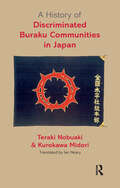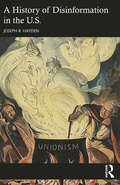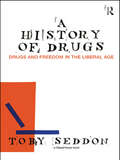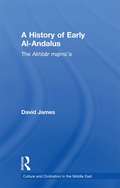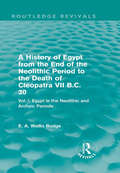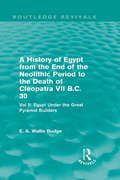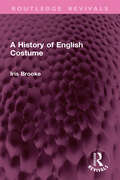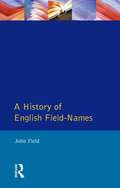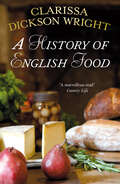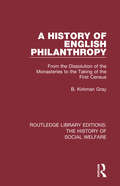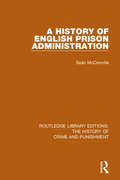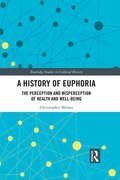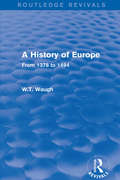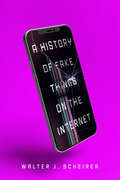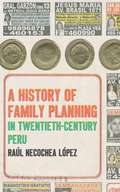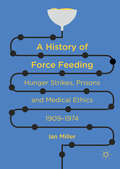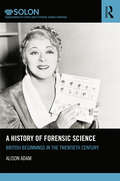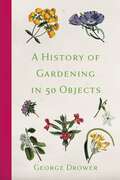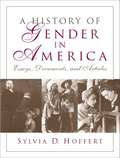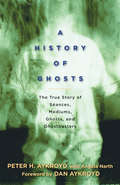- Table View
- List View
A History of Discriminated Buraku Communities in Japan
by Teraki Nobuaki Kurokawa MidoriAt the heart of modern Japan there remains an intractable and divisive social problem with its roots in pre-history, namely the ongoing social discrimination against the Dôwa communities, otherwise known as Buraku. Their marginalization and isolation within society as a whole remains a veiled yet contested issue. Buraku studies, once largely ignored within Japan’s academia and by scholarly publishers, have developed considerably in the first decades of the twenty-first century, as the extensive bibliographies of both Japanese and English sources provided here clearly demonstrates. The authors of the present study published in Japanese in 2016 and translated here by the Oxford scholar Ian Neary, have been able to incorporate this most recent data. Because of its importance as the first Buraku history based on this new research, a wider readership was always the authors’ principal focus. Yet, it also provides a valuable source book for further study by those wishing to develop their knowledge about the subject from an informed base. This history of the Buraku communities and their antecedents is the first such study to be published in English.
A History of Disinformation in the U.S.
by Joseph R. HaydenThis volume recounts notable episodes of distortion throughout American media history. It examines several of the lurid hoaxes and conspiracy theories that have inspired press coverage, as well as some of the political lies promoted by partisan gladiators, whether of the eighteenth century or today.The book moves beyond the sensational stories to show the enduring and systemic nature of media manipulation that occurs on far more consequential issues. It exposes persistent and deeply destructive falsehoods that have been told about women, people of color, immigrants, the LGBTQ+ community, unions, commercial products, highlighting how longstanding “bipartisan” myths have effectively marginalized certain groups of Americans. Alongside these cases, the author carefully dissects the changing nature of institutions, technologies, and practices of journalism in America. Attention is given to the evolution of newspapers in the eighteenth and nineteenth centuries, the role of broadcasting in the twentieth, and the impact of the internet and social media at the dawn of the twenty-first.This book will appeal to readers interested in American history, journalism, communication studies, political science and sociology.
A History of Drugs: Drugs and Freedom in the Liberal Age
by Toby SeddonWhy are some psychoactive substances regarded as ‘dangerous drugs’, to be controlled by the criminal law within a global prohibition regime, whilst others – from alcohol and tobacco, through to those we call ‘medicines’ – are seen and regulated very differently? A History of Drugs traces a genealogy of the construction and governance of the ‘drug problem’ over the past 200 years, calling into question some of the most fundamental ideas in this field: from ‘addiction’ to the very concept of ‘drugs’. At the heart of the book is the claim that it was with the emergence in the late eighteenth century of modern liberal capitalism, with its distinctive emphasis on freedom, that our concerns about the consumption of some of these substances began to grow. And, indeed, notions of freedom, free will and responsibility remain central to the drug question today. Pursuing an innovative inter-disciplinary approach, A History of Drugs provides an informed and insightful account of the origins of contemporary drug policy. It will be essential reading for students and academics working in law, criminology, sociology, social policy, history and political science.
A History of Early Al-Andalus: The Akhbar Majmu'a (Culture and Civilization in the Middle East)
by David JamesThe Akhbār majmū‘a, or 'Collected Accounts', deal with the Muslim conquest of the Iberian peninsula in 711 and subsequent events in al-Andalus, down to and including the reign of ‘Abd al-Rahmān III (912-961), founder of the Umayyad caliphate of al-Andalus . No Arabic text dealing with the early history of al-Andalus has aroused more controversy, and its contents and origin have occupied the attention of leading scholars of Islamic Spain since its publication in 1867. This book gives the first complete English translation of this key contemporary text, together with notes, comments, appendices and maps. It is introduced by a survey of scholarly opinion on the text from the nineteenth to the twenty-first century in which all the - often heated - arguments around the text are explained. The translator concludes his introduction with an in-depth examination of the manuscript containing the only surviving copy of the text and presents some interesting new evidence provided by scribe which has gone unnoticed until now. Providing new insights into this significant Arabic text, this book will be of great interest to scholars of the history of Spain and Portugal, Islamic history, and Mediaeval European history.
A History of Egypt from the End of the Neolithic Period to the Death of Cleopatra VII B.C. 30: Vol. I: Egypt in the Neolithic and Archaic Periods (Routledge Revivals)
by E. A. BudgeSir E. A. Wallis Budge (1857-1934) was Keeper of the British Museum’s department of oriental antiquities from 1894 until his retirement in 1924. Carrying out many missions to Egypt in search of ancient objects, Budge was hugely successful in collecting papyri, statues and other artefacts for the trustees of the British Museum: numbering into the thousands and of great cultural and historical significance. Budge published well over 100 monographs, which shaped the development of future scholarship and are still of great academic value today, dealing with subjects such as Egyptian religion, history and literature. This volume, first published in 1901 as part of the Egypt and Chaldaea series, is the first of eight volumes by Budge dealing with different periods in the history of Egypt. The narrative begins with an account of Egypt and her people in the latter part of the Neolithic period, and ends with the description of her conquest by the Romans under Caesar Octavianus, B.C. 30. Budge considers the great excavations of the nineteenth century in the first volume and, alongside detailed illustrations, provides a fascinating analysis of the dynastic kings.
A History of Egypt from the End of the Neolithic Period to the Death of Cleopatra VII B.C. 30: Vol. II: Egypt Under the Great Pyramid Builders (Routledge Revivals)
by E.A. Wallis BudgeSir E. A. Wallis Budge (1857-1934) was Keeper of the British Museum’s department of oriental antiquities from 1894 until his retirement in 1924. Carrying out many missions to Egypt in search of ancient objects, Budge was hugely successful in collecting papyri, statues and other artefacts for the trustees of the British Museum: numbering into the thousands and of great cultural and historical significance. Budge published well over 100 monographs, which shaped the development of future scholarship and are still of great academic value today, dealing with subjects such as Egyptian religion, history and literature. This volume, first published in 1902 as part of the Egypt and Chaldaea series, is the second of eight volumes by Budge dealing with different periods in the history of Egypt. The narrative ranges from the end of the 3rd Dynasty up to the close of the reign of Seānkh-ka-Rā, who was famous for the despatch of an expedition to Punt, and was the last king of the 6th Dynasty. This second volume deals with the Great Pyramid Builders of Egypt, and, alongside detailed illustrations, provides a fascinating analysis of the dynastic kings.
A History of Egypt: In the Middle Ages
by Stanley Lane-PooleWhen originally published in 1901, this volume related for the first time the History of Egypt in the Middle Ages, from its conquest by the Saracens in 640 to its annexation by the Ottoman Turks in 1517 in a continuous narrative apart from the general history of the Muslim caliphate.
A History of English Costume (Routledge Revivals)
by Iris BrookeOriginally published in 1937 and reprinted as a fourth edition in paperback in 1979, this is a history of dress in England from the Norman Conquest to the mid-20th century. Despite being an excellent resource for the student or designer, this book also provides a wealth of material for the social historian. Indeed, the author argues that costume is important because it is custom, and custom and habit have helped to shape history just as much as political machinations and geographical discoveries.
A History of English Field Names (Approaches to Local History)
by John FieldField names are not only interesting in themselves, but also a rich source of information about the communities originating them. The earliest recorded names often describe only the location or nature of the land, but changes in language, technology, social organisation, land ownership and even religious and political thinking have all contributed to a surprisingly complex picture today. A pioneering history.
A History of English Food
by Clarissa Dickson WrightIn this magnificent guide to England's cuisine, the inimitable Clarissa Dickson Wright takes us from a medieval feast to a modern-day farmers' market, visiting the Tudor working man's table and a Georgian kitchen along the way. Peppered with surprises and seasoned with wit, A History of England Food is a classic for any food lover.
A History of English Philanthropy: From the Dissolution of the Monasteries to the Taking of the First Census (Routledge Library Editions: The History of Social Welfare)
by B. Kirkman GrayFirst published in 1905, this book charts the history of English philanthropy from the Elizabethan period through to the nineteenth century. In doing so, Benjamin Kirkman Gray posed some important questions about modern philanthropy, and reflected on the meaning and worth of philanthropy. Through historical study, the author discussed this complex question, which, in a time before the development of the British welfare state, was particularly topical. This book will be of interest to those studying the history of philanthropy, social welfare and poverty.
A History of English Prison Administration (Routledge Library Editions: The History of Crime and Punishment #6)
by Sean McconvilleThis title, first published in 1981, draws from an extensive range of national and local material, and examines how innovations in policy and administration, while solving problems or setting new objectives, frequently created or disclosed fresh difficulties, and brought different types of people into the administration and management of prisons, whose interests, values and expectations in turn often had significant effects upon penal ideas and their practical applications. Special attention has been paid to the study of recruitment, the work and influence of gaolers, keepers, governors, and highly administrative officials. This comprehensive book will be of interest to students of criminology and history.
A History of Euphoria: The Perception and Misperception of Health and Well-Being (Routledge Studies in Cultural History #67)
by Christopher MilnesVery few people have not at some point in their lives believed themselves or their loved ones to be reasonably healthy when, in "reality", sickness was encroaching or never went away. Health has been deceiving us for thousands of years, but rarely have we entirely dispensed with it as a concept. This book sets out to establish why and how that might be. The first of its kind, this longue durée historical study explores some of the ways in which people in western societies and cultures have come to believe that they, or other people, have perceived or misperceived health, well-being and euphoria—a word which, before the twentieth century, usually named the experience of health. This book draws from a number of areas of historical research, including the histories of convalescence, addiction, madness and Sigmund Freud’s interest in Euphorie in his pre-psychoanalytical period.
A History of Europe: From 1378 to 1494
by W.T. WaughFirst published in 1932, this book looks at a period that has often been thought of as a time of general decline in the most characteristic features of medieval civilisation. While acknowledging decline in many areas during this period — the power of the Church, feudalism, guilds, the Hanseatic League, the autonomy of towns and the end of the two Roman empires — the author argues that there was also signs of development. National consciousness, the power of the bourgeoisie and trade and industry all rose markedly in this period alongside intellectual and artistic achievements outside of Italy. This book asserts that in amongst the failure and decline new forces were creating new substitutes.
A History of Fake Things on the Internet
by Walter ScheirerA Next Big Idea Club "Must Read" for December 2023 As all aspects of our social and informational lives increasingly migrate online, the line between what is "real" and what is digitally fabricated grows ever thinner—and that fake content has undeniable real-world consequences. A History of Fake Things on the Internet takes the long view of how advances in technology brought us to the point where faked texts, images, and video content are nearly indistinguishable from what is authentic or true. Computer scientist Walter J. Scheirer takes a deep dive into the origins of fake news, conspiracy theories, reports of the paranormal, and other deviations from reality that have become part of mainstream culture, from image manipulation in the nineteenth-century darkroom to the literary stylings of large language models like ChatGPT. Scheirer investigates the origins of Internet fakes, from early hoaxes that traversed the globe via Bulletin Board Systems (BBSs), USENET, and a new messaging technology called email, to today's hyperrealistic, AI-generated Deepfakes. An expert in machine learning and recognition, Scheirer breaks down the technical advances that made new developments in digital deception possible, and shares behind-the-screens details of early Internet-era pranks that have become touchstones of hacker lore. His story introduces us to the visionaries and mischief-makers who first deployed digital fakery and continue to influence how digital manipulation works—and doesn't—today: computer hackers, digital artists, media forensics specialists, and AI researchers. Ultimately, Scheirer argues that problems associated with fake content are not intrinsic properties of the content itself, but rather stem from human behavior, demonstrating our capacity for both creativity and destruction.
A History of Family Planning in Twentieth-Century Peru
by Raúl Necochea LópezAdding to the burgeoning study of medicine and science in Latin America, this important book offers a comprehensive historical perspective on the highly contentious issues of sexual and reproductive health in an important Andean nation. Raul Necochea Lopez approaches family planning as a historical phenomenon layered with medical, social, economic, and moral implications. At stake in this complex mix were new notions of individual autonomy, the future of gender relations, and national prosperity.The implementation of Peru's first family planning programs led to a rapid professionalization of fertility control. Complicating the evolution of associated medical services were the conflicting agendas of ordinary citizens, power brokers from governmental and military sectors, clergy, and international health groups. While family planning promised a greater degree of control over individuals' intimate lives, as well as opportunities for economic improvement through the effective management of birth rates, the success of attempts to regulate fertility was far from assured. Today, Necochea Lopez observes, although the quality of family planning resources in Peru has improved, services remain far from equitably available.
A History of Force Feeding: Hunger Strikes, Prisons and Medical Ethics, 1909–1974
by Ian MillerThis book is Open Access under a CC BY license. It is the first monograph-length study of the force-feeding of hunger strikers in English, Irish and Northern Irish prisons. It examines ethical debates that arose throughout the twentieth century when governments authorised the force-feeding of imprisoned suffragettes, Irish republicans and convict prisoners. It also explores the fraught role of prison doctors called upon to perform the procedure. Since the Home Office first authorised force-feeding in 1909, a number of questions have been raised about the procedure. Is force-feeding safe? Can it kill? Are doctors who feed prisoners against their will abandoning the medical ethical norms of their profession? And do state bodies use prison doctors to help tackle political dissidence at times of political crisis?
A History of Forensic Science: British beginnings in the twentieth century (Routledge SOLON Explorations in Crime and Criminal Justice Histories)
by Alison AdamHow and when did forensic science originate in the UK? This question demands our attention because our understanding of present-day forensic science is vastly enriched through gaining an appreciation of what went before. A History of Forensic Science is the first book to consider the wide spectrum of influences which went into creating the discipline in Britain in the first part of the twentieth century. This book offers a history of the development of forensic sciences, centred on the UK, but with consideration of continental and colonial influences, from around 1880 to approximately 1940. This period was central to the formation of a separate discipline of forensic science with a distinct professional identity and this book charts the strategies of the new forensic scientists to gain an authoritative voice in the courtroom and to forge a professional identity in the space between forensic medicine, scientific policing, and independent expert witnessing. In so doing, it improves our understanding of how forensic science developed as it did. This book is essential reading for academics and students engaged in the study of criminology, the history of forensic science, science and technology studies and the history of policing.
A History of Gardening in 50 Objects
by George DrowerThe earliest record of an enclosed space around a homestead come from 10,000 BC and since then gardens of varying types and ambition have been popular throughout the ages. Whether ornamental patches surrounding wild cottages, container gardens blooming over unforgiving concrete or those turned over for growing produce, gardens exist in all shapes and sizes, in all manner of styles.Today we benefit from centuries of development, be it in the cultivation of desirable blossom or larger fruits, in the technology to keep weeds and lawn at bay or even in the visionaries who tore up rulebooks and cultivated pure creativity in their green spaces.George Drower takes fifty objects that have helped create the gardening scene we know today and explores the history outside spaces in a truly unique fashion. With stunning botanical and archive images, this lavish volume is essential for garden lovers.
A History of Gender in America: Essays, Documents, and Articles
by Sylvia D. HoffertA reader for an undergraduate course assembling recent literature on the history of gender in the US, with section introductions setting the context of the period covered. A list of suggested readings replaces a bibliography. There is no index. Annotation c. Book News, Inc., Portland, OR (booknews.com)
A History of Ghosts: The True Story of Séances, Mediums, Ghosts, and Ghostbusters
by Peter H. Aykroyd Angela NarthPeter Aykroyd spent his childhood watching his family's parlor séances through the crack of a basement door. Here, for the first time, Aykroyd tells the strange and delightful story that inspired his son, Dan, to make the mega-hit, Ghostbusters. Part history, part family legend, A History of Ghosts starts in 1848 in upstate New York, where the spiritualist craze first began. Aykroyd introduces the reader to notable mediums while telling the story of the development of spiritualism, interweaving a personal history marked by a fascination with ghosts and spirits with the larger narrative about the role the paranormal has played in our culture. Such legendary figures as Sir Arthur Conan Doyle and Harry Houdini appear and vanish. Everyone loves a good ghost story. Successful TV shows such as Medium and Ghost Hunters are proof that our national obsession with ghosts is here to stay. Millions of Americans believe in the paranormal—and even skeptics have heard a bump in the night and suspected it might be something supernatural.
A History of Global Consumption: 1500 - 1800
by Ina Baghdiantz McCabeIn A History of Global Consumption: 1500 – 1800, Ina Baghdiantz McCabe examines the history of consumption throughout the early modern period using a combination of chronological and thematic discussion, taking a comprehensive and wide-reaching view of a subject that has long been on the historical agenda. The title explores the topic from the rise of the collector in Renaissance Europe to the birth of consumption as a political tool in the eighteenth century. Beginning with an overview of the history of consumption and the major theorists, such as Bourdieu, Elias and Barthes, who have shaped its development as a field, Baghdiantz McCabe approaches the subject through a clear chronological framework. Supplemented by illlustrations in every chapter and ranging in scope from an analysis of the success of American commodities such as tobacco, sugar and chocolate in Europe and Asia to a discussion of the Dutch tulip mania, A History of Global Consumption: 1500 – 1800 is the perfect guide for all students interested in the social, cultural and economic history of the early modern period.
A History of Groves (Routledge Research in Landscape and Environmental Design)
by Jan Woudstra Colin RothThe grove, a grouping of trees, intentionally cultivated or found growing wild, has a long diverse history entwined with human settlement, rural practices and the culture and politics of cities. A grove can be a memorial, a place of learning, a site of poetic retreat and philosophy or political encampment, a public park or theatre, a place of hidden pleasures, a symbol of a vanished forest ecology, or a place of gods or other spirits. Yet groves are largely absent from our contemporary vocabulary and rarely included in today’s landscape practice, whether urban or rural. Groves are both literal and metaphorical manifestations, ways of defining spaces and ecologies in our cultural life. Since they can add meaning to urban forms and ecologies and contribute meaningfully to the significance of place, critical examination is long overdue. The editors have taken care to ensure that the text is accessible to the general reader as well as specialists.
A History of Hittite Literacy: Writing and Reading in Late Bronze-Age Anatolia (1650–1200 BC)
by Theo van HoutWhy did the Anatolians remain illiterate for so long, although surrounded by people using script? Why and how did they eventually adopt the cuneiform writing system and why did they still invent a second, hieroglyphic script of their own? What did and didn't they write down and what role did Hittite literature, the oldest known literature in any Indo-European language, play? These and many other questions on scribal culture are addressed in this first, comprehensive book on writing, reading, script usage, and literacy in the Hittite kingdom (c.1650–1200 BC). It describes the rise and fall of literacy and literature in Hittite Anatolia in the wider context of its political, economic, and intellectual history.
A History of Honey in Georgia and the Carolinas (American Palate)
by April AldrichIn the late 1800s, Georgia and the Carolinas produced millions of pounds of honey and created a lasting legacy within the industry. The uses for the sweet nectar go well beyond flavor. Bee pollination extensively benefits agricultural crops in the area. Elements from the beehive are commonly used in popular cosmetics, medicines and mead. Beekeepers also face serious challenges like Colony Collapse Disorder. Join author and beekeeper April Aldrich as she traces the delectable history of honey and beekeeping throughout the region, from ancient apiaries to modern meaderies and beyond.
